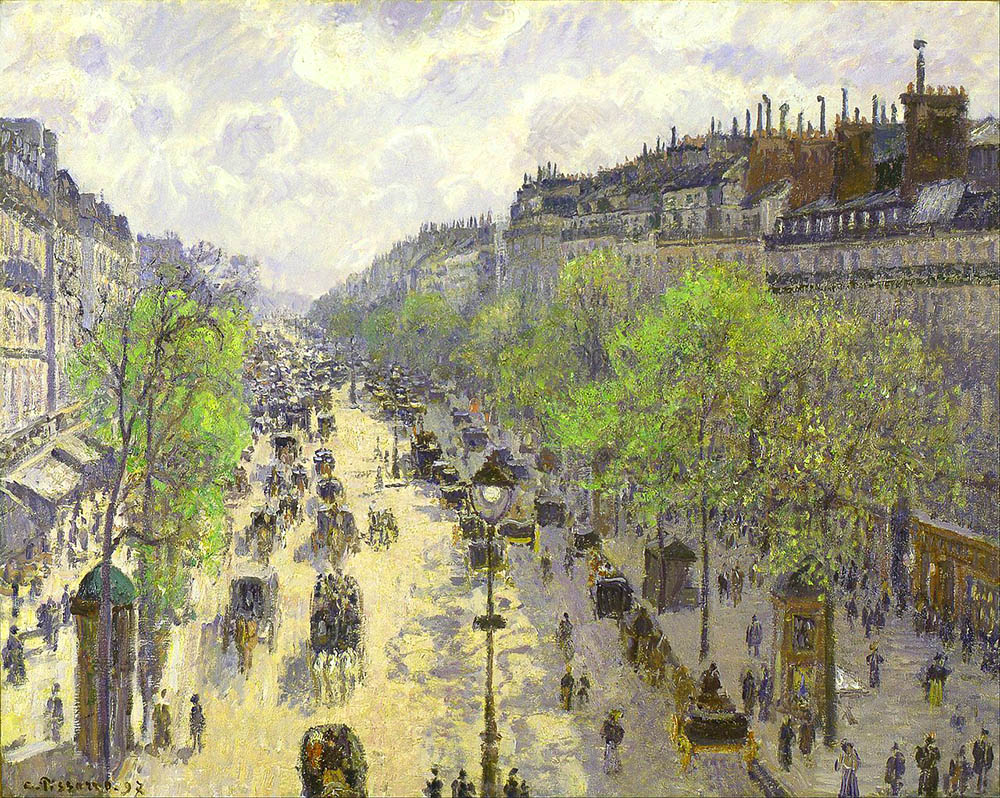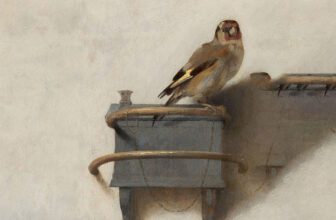
Boulevard Montmartre, Spring by Camille Pissarro
A Deep Analysis and Interpretation of a Masterpiece
Camille Pissarro, one of the key figures in the development of Impressionism, left behind a prolific body of work that continues to captivate art lovers and scholars alike. Among his many celebrated paintings, Boulevard Montmartre, Spring stands out not only for its technical brilliance but also for its rich symbolic content, historical significance, and emotional resonance. Created in 1897, this painting is part of a remarkable series in which Pissarro captured the Boulevard Montmartre in Paris at different times of the day and under various weather conditions. In this comprehensive exploration, we’ll delve into the painting’s meaning, style, symbolism, and historical context, revealing why Boulevard Montmartre, Spring remains a timeless testament to the power of observation and artistic interpretation.
The Context Behind the Canvas
To understand Boulevard Montmartre, Spring, we must first consider the context in which it was painted. The 1890s were a transformative period in Parisian history. The city was undergoing major modernization efforts under the Haussmannization initiative, with wide boulevards, new architecture, and urban parks transforming the medieval labyrinth into the Paris we recognize today.
Camille Pissarro, born in 1830 in the Danish West Indies, spent most of his adult life in France and was deeply influenced by these changes. By the time he painted the Boulevard Montmartre series, he was an elder statesman of Impressionism and had experimented with various techniques, including Pointillism and Neo-Impressionism, before returning to a more fluid Impressionist style. In 1897, Pissarro rented a room at the Hôtel de Russie on the Place du Théâtre Français, which gave him a vantage point to observe and paint the dynamic boulevard scenes below.
What is Boulevard Montmartre, Spring All About?
At its core, Boulevard Montmartre, Spring is a celebration of urban life at the turn of the century. The painting portrays the bustling Parisian street of Boulevard Montmartre teeming with life, horse-drawn carriages, pedestrians, and lush spring foliage line the avenue. But it is not merely a documentary depiction of a street. Instead, it is Pissarro’s meditation on the rhythm of modern life, the harmony of nature and urbanity, and the fleeting beauty of a spring day.
Pissarro painted the Boulevard Montmartre multiple times under varying conditions, morning, afternoon, evening, fog, rain, and sunlight. Boulevard Montmartre, Spring captures the city during the height of the vernal season, with its liveliness and luminosity rendering a joyful tone. This version is imbued with a sense of rejuvenation and serenity, characteristics associated with spring. Yet, it retains the dynamism and complexity of city life, reflecting both continuity and change.
Artistic Style: Impressionism in Full Bloom
Boulevard Montmartre, Spring is quintessentially Impressionist in its style. Pissarro employs rapid, visible brushstrokes to evoke the fleeting effects of light and atmosphere. The canvas is alive with dappled hues, shades of green from the budding trees, pastel blossoms, muted greys and browns from the buildings, and subtle pops of color from the clothing of passersby.
What distinguishes this work is Pissarro’s balanced composition. The street stretches into the horizon, flanked by symmetrical rows of trees and buildings. This linear perspective draws the viewer’s eye into the painting, creating depth and movement. The elevated vantage point, typical of Pissarro’s urban scenes, offers a bird’s-eye view that feels both detached and intimate.
Rather than focusing on a single subject, the painting envelops the viewer in the totality of the scene, the architecture, nature, and people all contribute to the symphonic quality of the image. This holistic approach underscores Pissarro’s belief that the ordinary is worthy of celebration and artistic exploration.
What is Happening in the Painting?
In Boulevard Montmartre, Spring, Pissarro captures a typical Parisian day in the late 19th century. The painting is filled with activity, carriages make their way along the boulevard, elegant women stroll under blooming trees, and shops and buildings hum with quiet energy. There’s no single narrative focal point, which is precisely the point. Pissarro offers a slice-of-life tableau that invites the viewer to interpret each figure and movement as part of a larger urban story.
The depiction of both motion and stillness is striking. While the carriages and pedestrians convey movement, the trees, buildings, and distant skyline provide a static, grounding presence. This interplay adds complexity and realism, reflecting Pissarro’s keen observational skills and his desire to portray life as it is, not as a frozen moment, but as a fluid experience.
Symbolism and Interpretation
1. Spring as a Metaphor:
Spring in the painting symbolizes renewal, growth, and hope. In the late 19th century, Paris was undergoing dramatic changes, technological, social, and cultural. The freshness of spring mirrors this transformation, representing a new beginning not only for nature but for society.
2. The Urban as a Living Organism:
Pissarro doesn’t merely paint a cityscape; he animates it. The boulevard, with its ebb and flow of traffic and people, is portrayed almost as a living being. This suggests a deeper philosophical reading: the city, like nature, has its own rhythms, seasons, and vitality.
3. Egalitarian Vision:
A lifelong anarchist, Pissarro believed in the dignity of all people, regardless of class. In his painting, there is no glorified elite or vilified poor, everyone shares the space. The equal treatment of figures in the crowd reflects his political beliefs and his humanist approach to art.
4. Light and Time:
The dappled sunlight filtering through the trees suggests a specific time of day, likely late morning or early afternoon. But it also serves as a symbol of temporality. Like light, life is transient. The painting captures a fleeting moment, reminding us of the impermanence of all things.
5. Nature Amidst Urbanity:
The blooming trees serve as a poignant juxtaposition to the manmade environment. Pissarro seems to suggest that even in the most urbanized settings, nature persists. The harmony between the two elements conveys a vision of coexistence, rather than conflict.
Composition and Color
Pissarro’s compositional genius is evident in the balance and harmony of the painting. The central boulevard acts as a natural axis, flanked by buildings that create a visual corridor. The aerial perspective not only organizes the chaos of the city but also elevates the viewer into the position of observer, rather than participant.
His use of color is equally masterful. The palette is soft yet vibrant, pinks and whites of spring blossoms, pale blues in the sky, the earthy tones of buildings, and the vivid attire of the people below. The brushstrokes are loose, yet controlled enough to suggest form and movement. These techniques create an immersive, emotionally resonant experience.
Where is Boulevard Montmartre, Spring Today?
Today, Boulevard Montmartre, Spring is housed in the National Gallery of Art in Washington, D.C. It is part of the Chester Dale Collection, a major bequest that brought many Impressionist and Post-Impressionist masterpieces to the museum. The painting is accessible to the public and continues to inspire new generations of artists, historians, and admirers.
Its placement in one of the world’s leading art institutions underscores its importance, not just as a beautiful representation of Parisian life, but as a cornerstone of Impressionist art. Visitors who view the painting in person often remark on its luminous quality and emotional depth, qualities that are difficult to fully appreciate in reproductions.
Boulevard Montmartre, Spring is more than just a painting, it is a window into a bygone era, a philosophical statement, and a technical tour de force. It stands at the intersection of art, politics, and urban studies, offering insights into how we live, observe, and connect.
Pissarro’s boulevard series also paved the way for future generations of urban painters, from the modernists of the early 20th century to contemporary artists exploring city life. His ability to find poetry in the everyday remains profoundly relevant in a world that often overlooks the beauty in the mundane.
Moreover, the painting invites viewers to slow down and observe, to notice the interplay of light and shadow, the choreography of crowds, the subtle drama of a passing carriage. In an age of rapid consumption and distraction, Pissarro’s work is a gentle reminder of the richness that lies in stillness and attention.
Camille Pissarro’s Boulevard Montmartre, Spring is a masterpiece of observation, emotion, and technique. It captures the spirit of a city in flux, the elegance of springtime, and the democratic eye of an artist who found beauty in all things. Through its detailed composition, luminous color palette, and symbolic depth, the painting transcends its time and place, offering a timeless reflection on life, nature, and the modern experience.
As we stand before it, whether in a gallery or through digital reproduction, we are reminded of the quiet grandeur of daily life and the enduring power of art to illuminate the world around us. In Boulevard Montmartre, Spring, Pissarro doesn’t just paint a street; he paints a symphony of life, harmonizing nature and modernity in a single, unforgettable vision.




